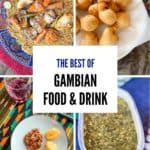Rich in colour and ritual, Gambian cuisine is a delight to explore. Take your tastebuds on a journey through peanuts and lemon juice, baobab and wonjo juice, with this guide to traditional food and drink in The Gambia.
Note: read this article first if you’re not sure if The Gambia is worth visiting
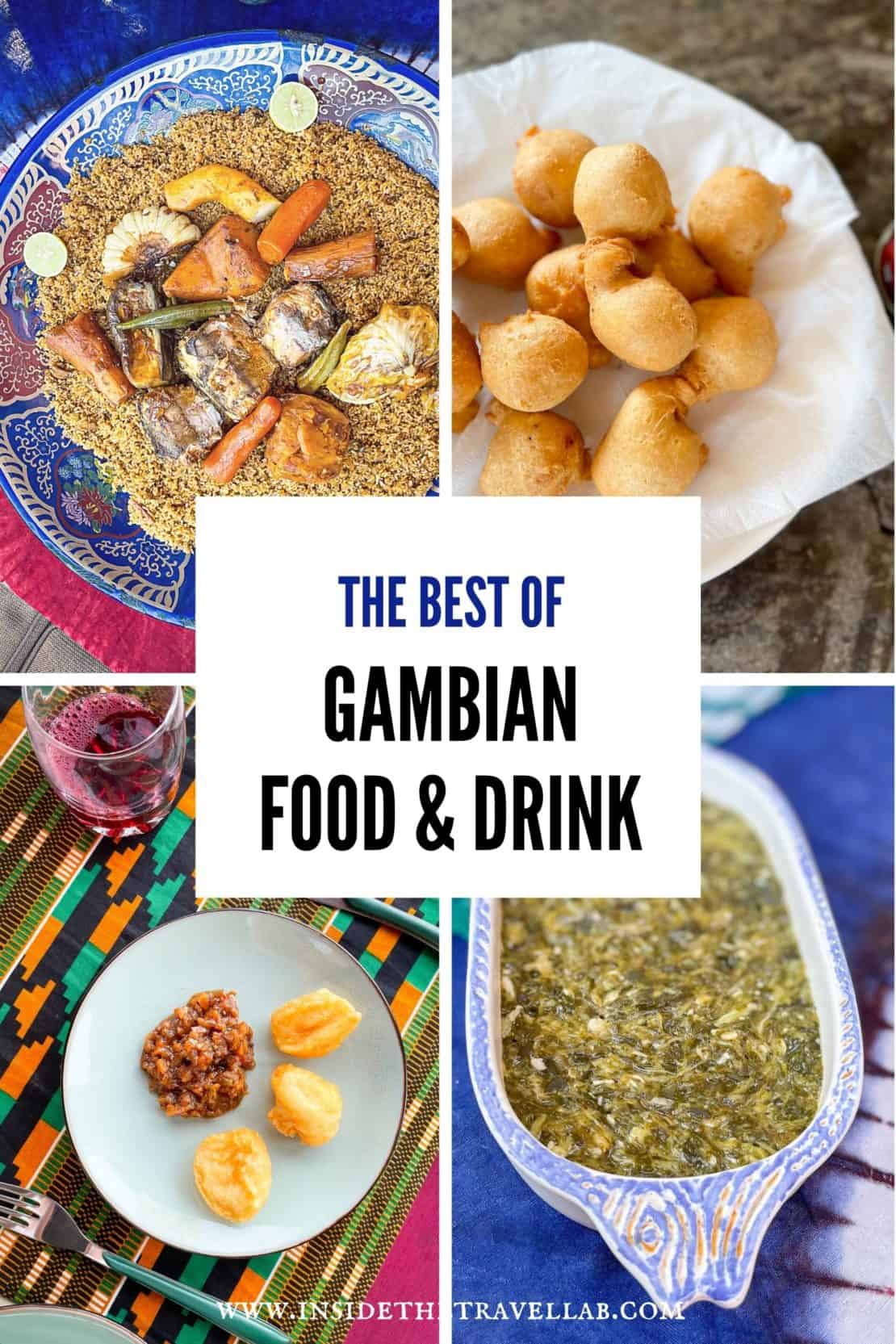
An Introduction to Food & Drink in The Gambia
On a sliver of sand tinged land that creeps to the east along the river Gambia itself, you’ll find The Gambia. It’s not a huge country. In fact, it ranks as the smallest country on mainland Africa, a fact that you’ll hear again and again.
But, as they say, size isn’t everything.
With miles of sun-soaked coastlines, plus rich and fertile land in the interior, Gambian cuisine offers more flavour, texture and fun than you might expect.
At least, it did to me. While many of the tourist resorts serve a wide range of European and American food, most chefs can rustle up some traditional, homemade Gambian cuisine if you ask nicely.
And if you venture out to the markets and eateries beyond the resorts, you will, of course, find even more. I know that people say that the phrase “an explosion of colour” is overused. But in The Gambia, it seems it isn’t used enough.
Whatever you do, I’d highly recommend taking a cooking class with the one-woman-legend, Ida.
But I’m getting ahead of myself. First, let’s talk practicalities.
Disclosure – I travelled to The Gambia recently as a guest of The Gambia Experience. As ever, as always, I kept the right to write what I like. Also, if you book or buy through any of the links on this page, I may earn a small commission at no extra cost to you. Cheers!
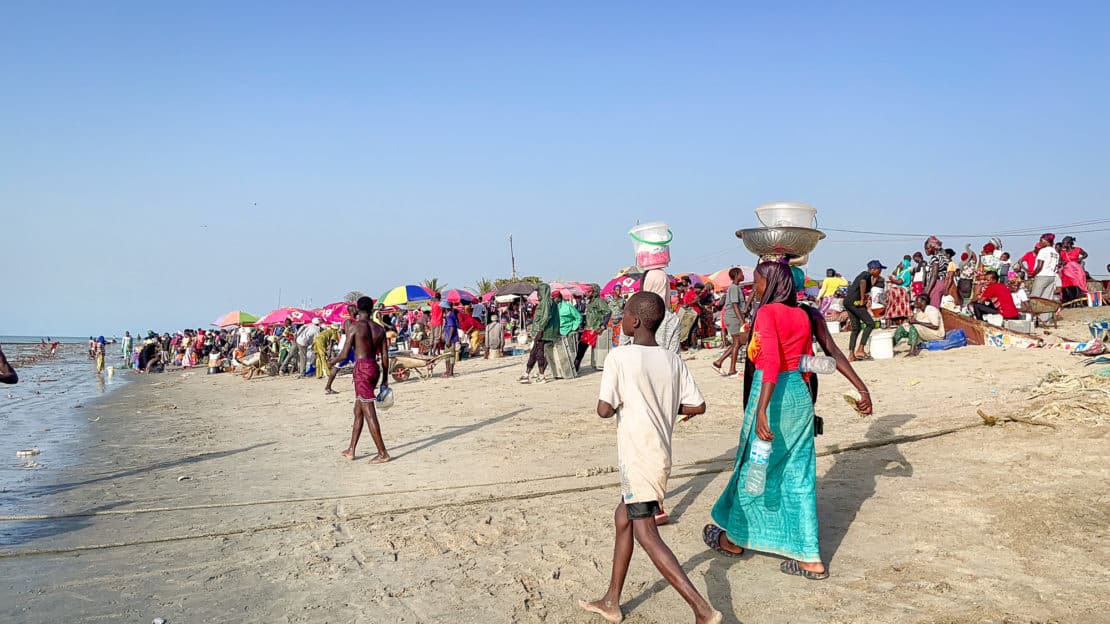
How to Travel to The Gambia
At the time of writing, the only way to fly to The Gambia from the UK is to travel with The Gambia Experience. Flights last around six hours on a charter flight and you can upgrade to Star Class if you wish, which brings a spare seat between you and the next passenger, delicious food, unlimited drinks, lounge access, faster check-in and a blanket. Note, you need to bring your own multimedia entertainment, regardless of which class you’re in.
There is no time difference between London and Banjul, which makes a whole host of things much easier.
How to make it happen
The Gambia Experience, my partners for the recent trip, currently have the following offers running:
- Book by 31st January 2023 and only pay a £75 deposit.
- Save up to £150 per booking on package holidays, including 20kg luggage, in-flight meal and transfer.
So, if a trip to West Africa has always been on your bucket list, then check out the deals over here.
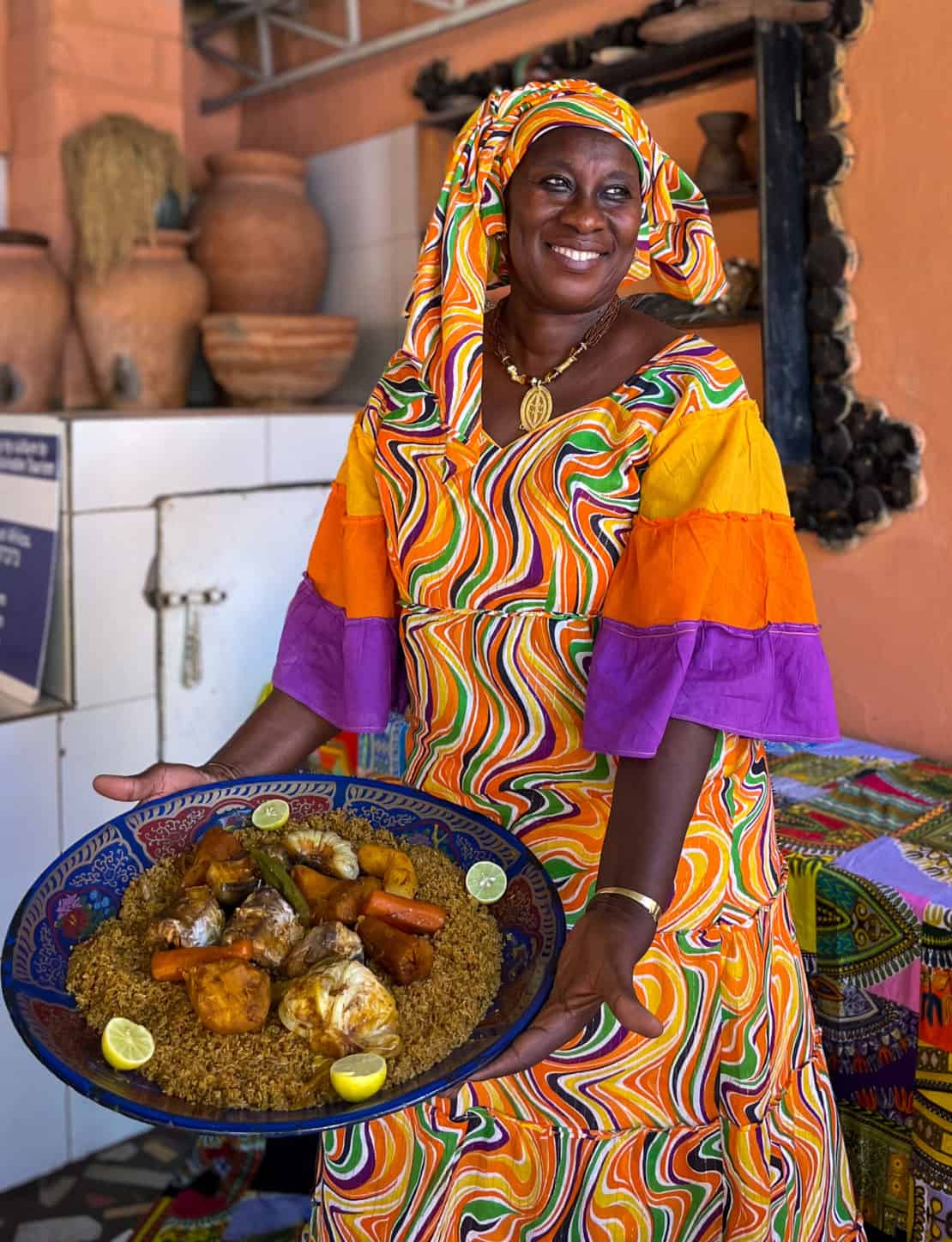
Traditional Dishes Served in The Gambia
The most common ingredients found along The Gambia River are rice, tomatoes, cassava, peanuts, and spicy peppers.
The Atlantic ocean proffers a rich variety of fish pulled daily straight to the sand. If you get the chance at all, head to the Tanji fish market and see the fishing boats pass their catch onto the heads and shoulders of the men and women who wade out waist deep to collect them.
Tips on dining etiquette for The Gambia
- Gambians traditionally serve food in one bowl right in the middle of the table. Every one eats from the part of the bowl right in front of them, using their right hand.
- If there are larger pieces of meat or vegetables that have been left whole, you also use your right hand to break them into smaller pieces. Many times, the host will do this for you and place the pieces in your section of the bowl.
- Eating with your right hand is the traditional way to do it but asking for a spoon is also acceptable.
- Never use your left hand – Gambians, like much of the world, reserve it for toileting purposes.
- Lastly, don’t lick your fingers until you are fully done eating. It’s easy to understand why.
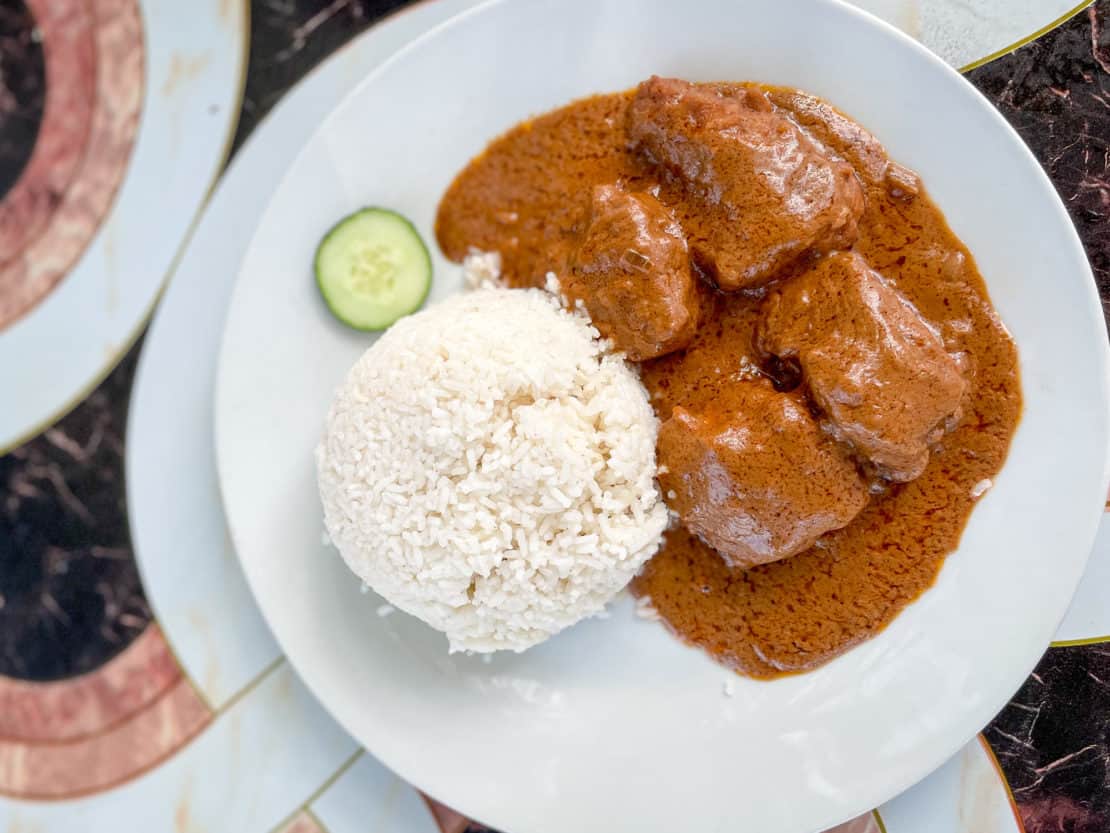
Domoda (Peanut or Groundnut Stew)
As the national dish of Gambia, domoda (pronounce duh-MAR-da) is a rich stew made with peanuts or ground nuts and popular across West Africa. The recipe varies from region to region: some places use unsweetened peanut butter for the peanut sauce, whilst others add flour to thicken the sauce instead of peanut paste. The stew also includes onions, sweet potatoes, and tomatoes and can come with either chicken, beef, or lamb.
Superkanja (Okra Stew)
A simple dish found both in urban and rural areas, this okra stew is both nutritious and delicious. You will find many versions of it across The Gambia and West Africa, but the base for all is a mixture of okra and fish boiled in palm oil. The locals top superkanja with onion and pepper, add a few spices and serve it over a rice dish.
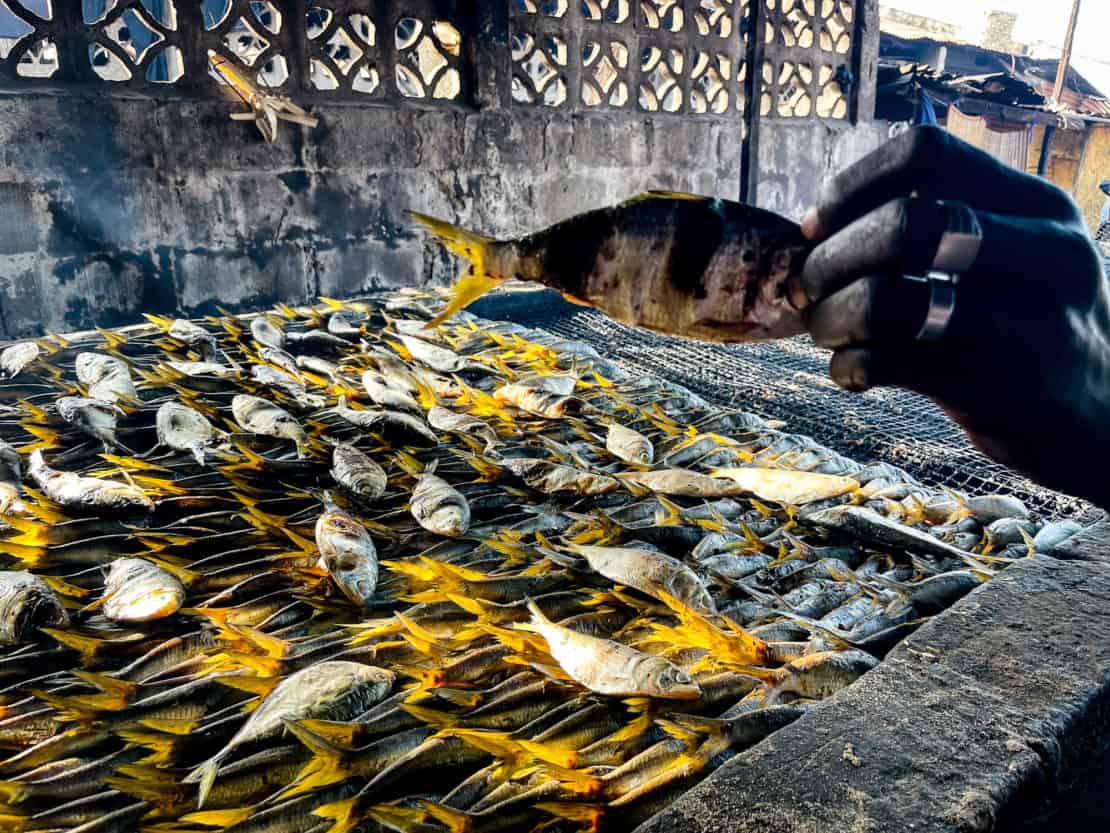
Mbahal (Salted Fish)
For such a small country, Gambia has a surprising number of versions of Mbahal, a mouth-watering local dish cooked with smoked, salted fish, groundnuts, black-eyed beans, and okras. Some recipes also include fresh chillis, bitter tomato, and spring onion. The best place to enjoy a traditional Mbahal is at someone’s house on a Friday, when this dish is usually cooked.
Chewi Kong (Catfish Stew)
Yet another example of traditional African cooking, Chewi Kong started in The Gambia and quickly became popular in Senegal and other West African countries. The main ingredient is catfish, which is washed with lime and hot water before being added to a simmering pot of onions, tomatoes, cabbage, carrots, cassava, and garlic, previously fried in vegetable oil. A pinch of salt and pepper and a nice bowl of white rice complete this hearty dish.
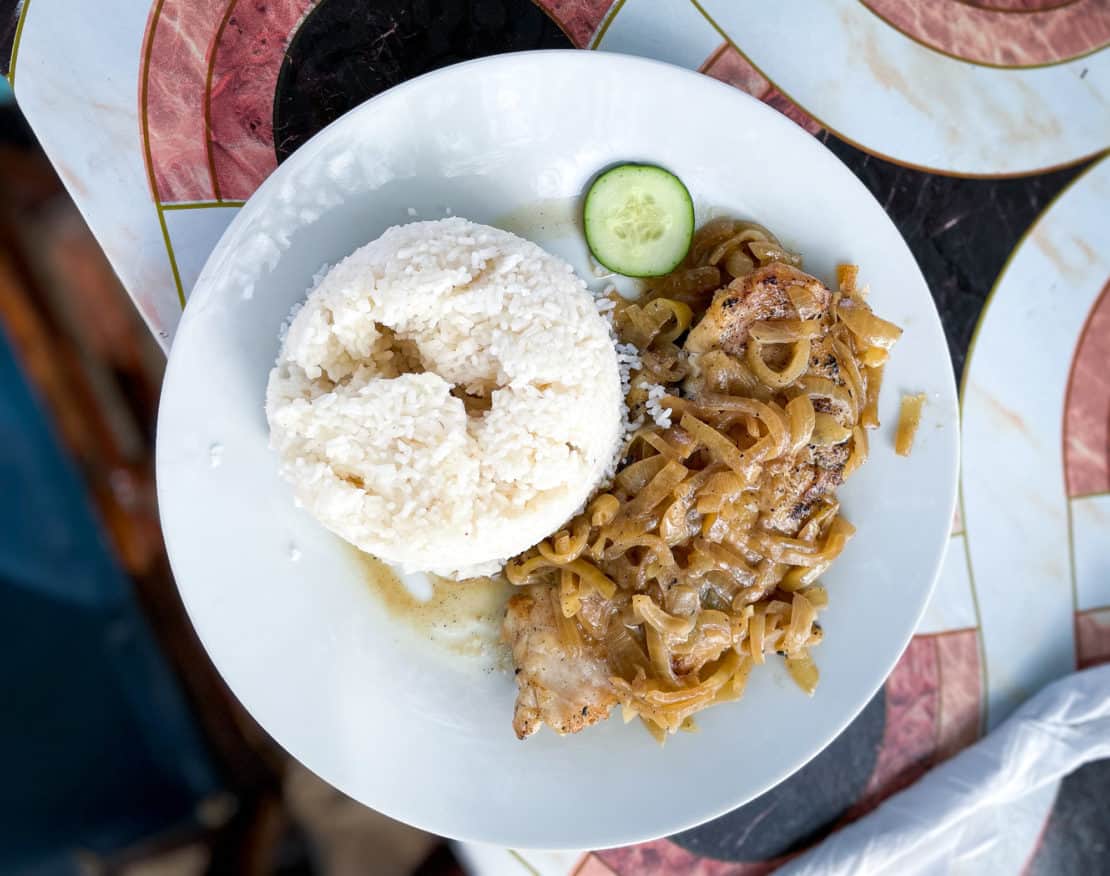
Fish Yassa (Curried Fish)
When it comes to West African food, Fish Yassa is one of the holy trinity of dishes (along with domada and benachin.)
Traditionally, yassa was a chicken dish but with easy access to the coast, fish yassa appears on the menu just as much.
The base includes a mixture of garlic, lemon juice, mustard, and hot pepper, in which the fish is left to marinade. It is then fried or grilled and returned to the sauce before being served on a bed of rice.
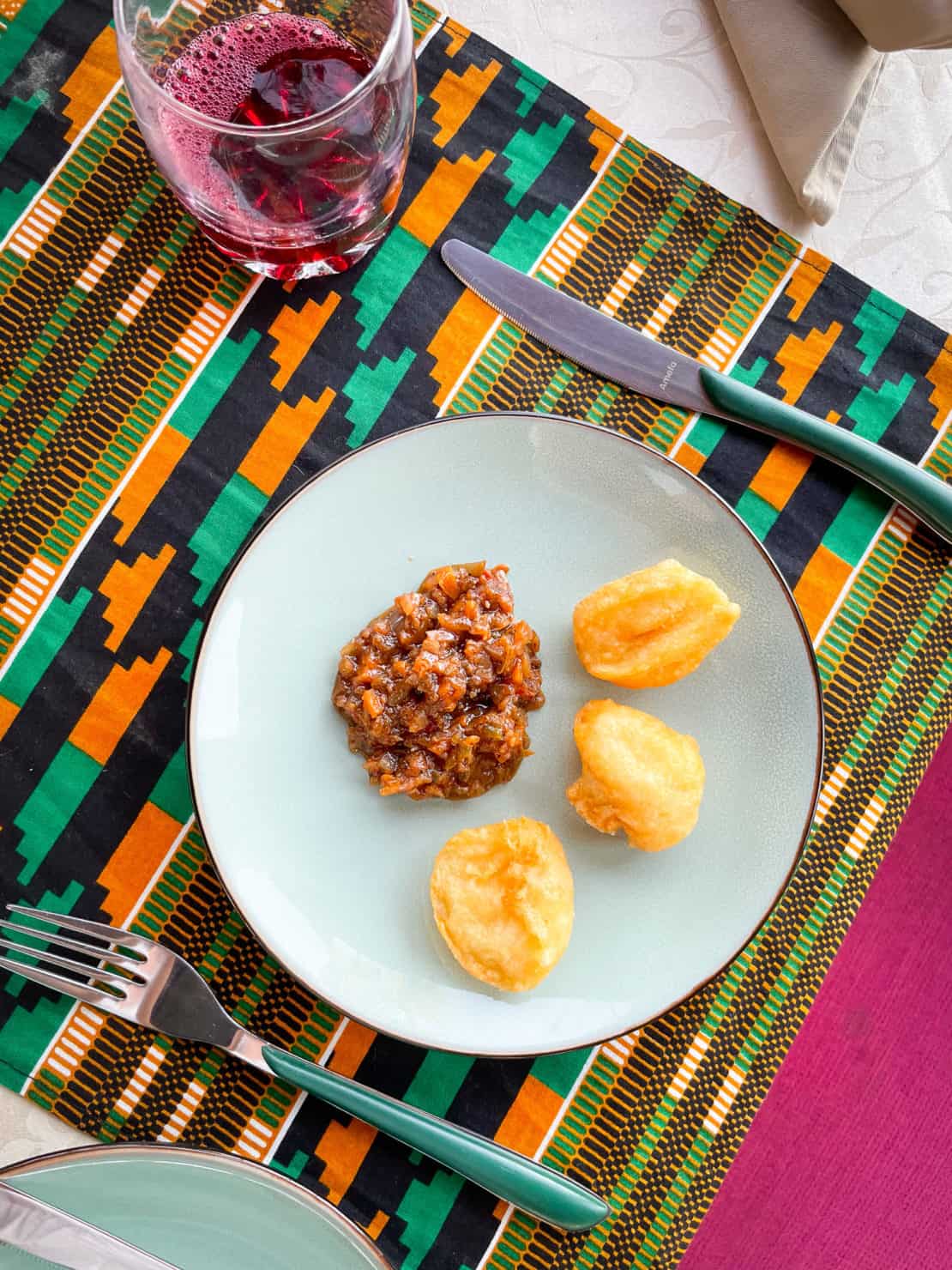
Akara (Bean Fritters)
Many hotels in The Gambia include this dish in their breakfast menu, serving it next to tapalapa bread and a sauce made from chilli, onions, and spices. It is one of the most popular foods in the country, made from a black-eyed peas paste, seasoned with onions and peppers and deep fried.
And it is dangerously moreish.
Ebbeh (Fish and Vegetable Soup)
If you ever feel like ordering soup, Ebbeh is your best choice. Chunky and hot, with lots of vegetables and seafood, this dish feels like heaven after you’ve completed a hiking trail in one of The Gambian natural parks. It is made with sweet potatoes, cassava, coco yam, chilli peppers and palm oil, all mixed with lime juice, a few bullion cubes, and tamarind.
Lastly, crabs, prawns, catfish, and bonga fish chunks are added to the dish, creating one of the best fish and vegetable soups in the country.
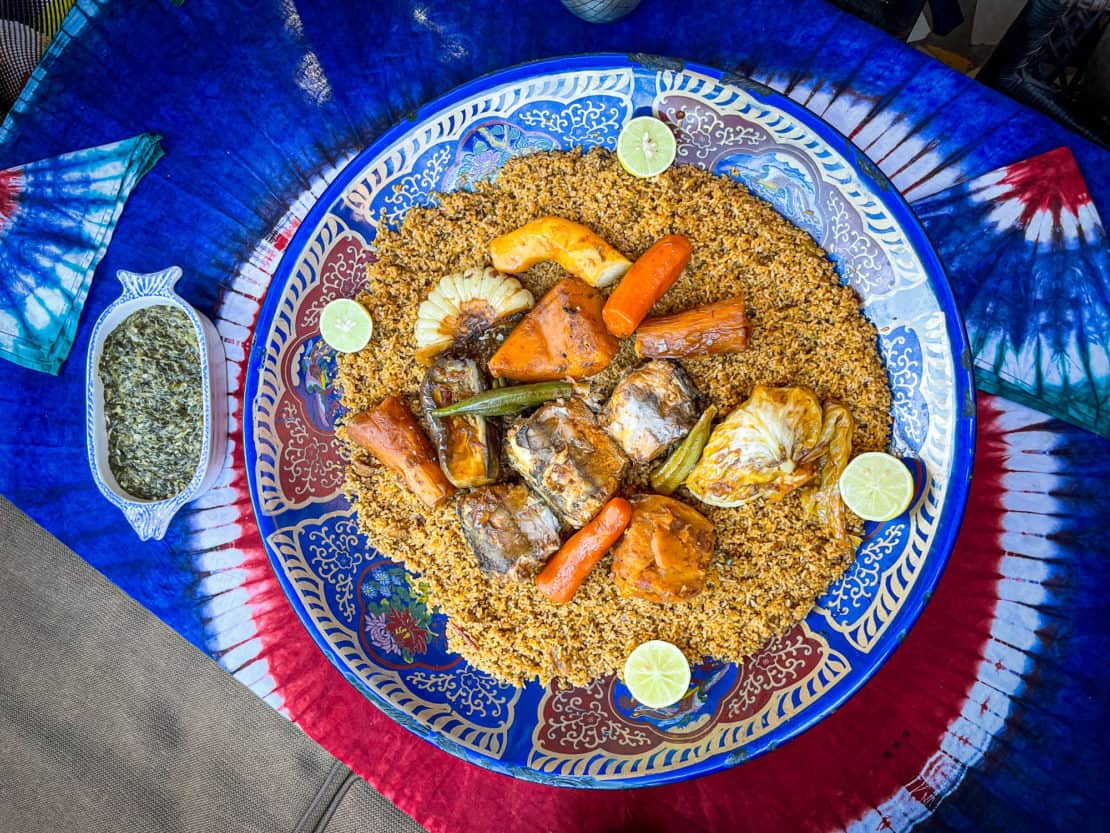
Benachin (Gambian Jollof Rice)
This popular Gambian food is based on rice, tomato paste, chilli peppers, tomatoes, and onions, all cooked together in one big pot. When everything is simmering in a delicious spicy sauce, salt and spices are added for even more flavour. Benachin (pronounced ben – a – keen) can be served plain, but when possible, people add beef, chicken, mutton, or fish to the pot, depending on availability.
Nyambeh Nyebeh (Cassava and Beans)
Nyambeh nyebeh is a type of African food mostly eaten as dinner. The name literally translates as cassava and beans, which form the main ingredients.
What sets nyambeh nyebeh apart from other Gambian dishes is that it is cooked in three different pots. The beans and cassava are boiled separately, drained, and salted. In a third pot, a stew made from white onions, spring onions, and pepper is prepared. When everything is perfectly cooked, the beans are added over the cassava and topped with the stew. Simply delicious!
Afra (Street meat)
If you go out at night in the big cities of The Gambia, you’ll find the streetside grills or dibiteries cooking Afra. Also known as Dibi, this dish consists of lamb, beef, chicken, fish, or bushmeat rubbed with stock cubes and grilled to perfection. Add a side of caramelised onions and mustard, and you’ve got yourself a heavenly late-night snack.
Fish Cakes and Sauce
Another popular late night street food are these fish cakes, which have precisely zero fish in them. But don’t let a mere detail like that get in the way!
The dough is made from flour, salt, and fat, rolled and then cut into circles. The vendor will fry them for you on the spot and serve them with an incredible sauce made from onions, salt, pepper, and jumbo. All you need to do is drip the sauce on the cakes and enjoy them.
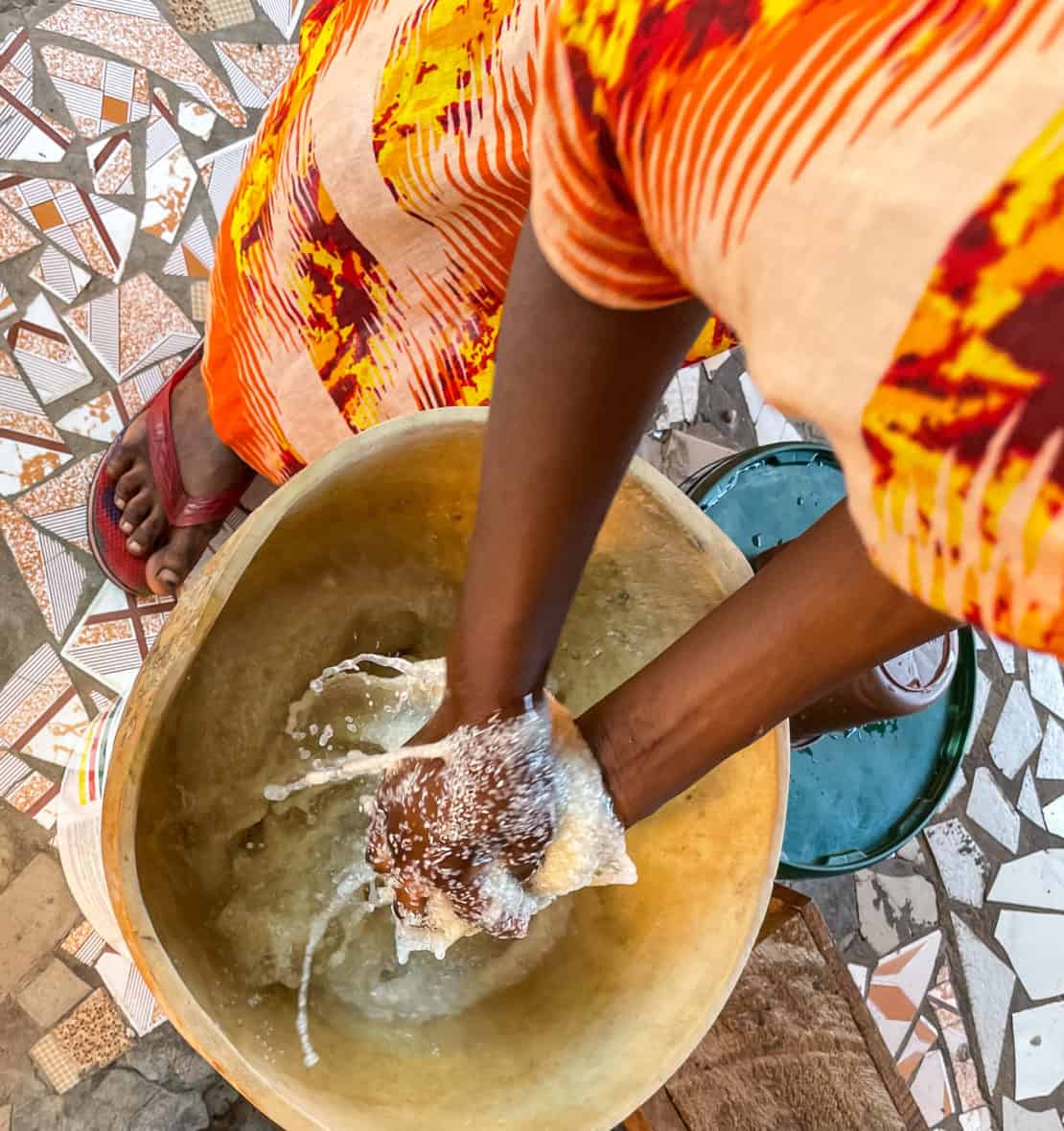
Side dishes in Gambian Cuisine
Cherreh
The tiny, steamed millet balls of cherreh soak up flavours and juices really well.
Fonio
Currently hitting international headlines as a supergrain, fonio looks a little like couscous and goes well with sauces and marinades.
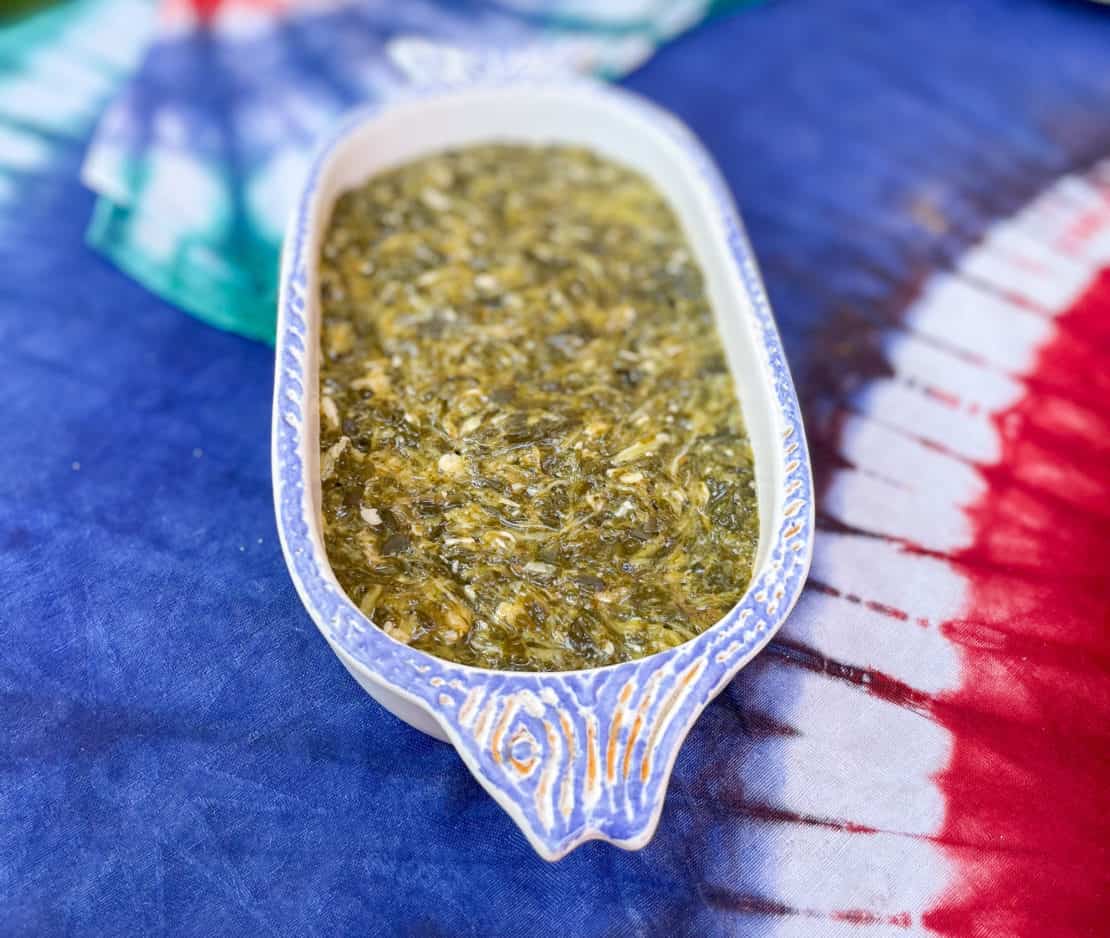
Bissap
Often described as a kind of spinach blend, you’ll find it as a side dish served with a mash of okra and onion.
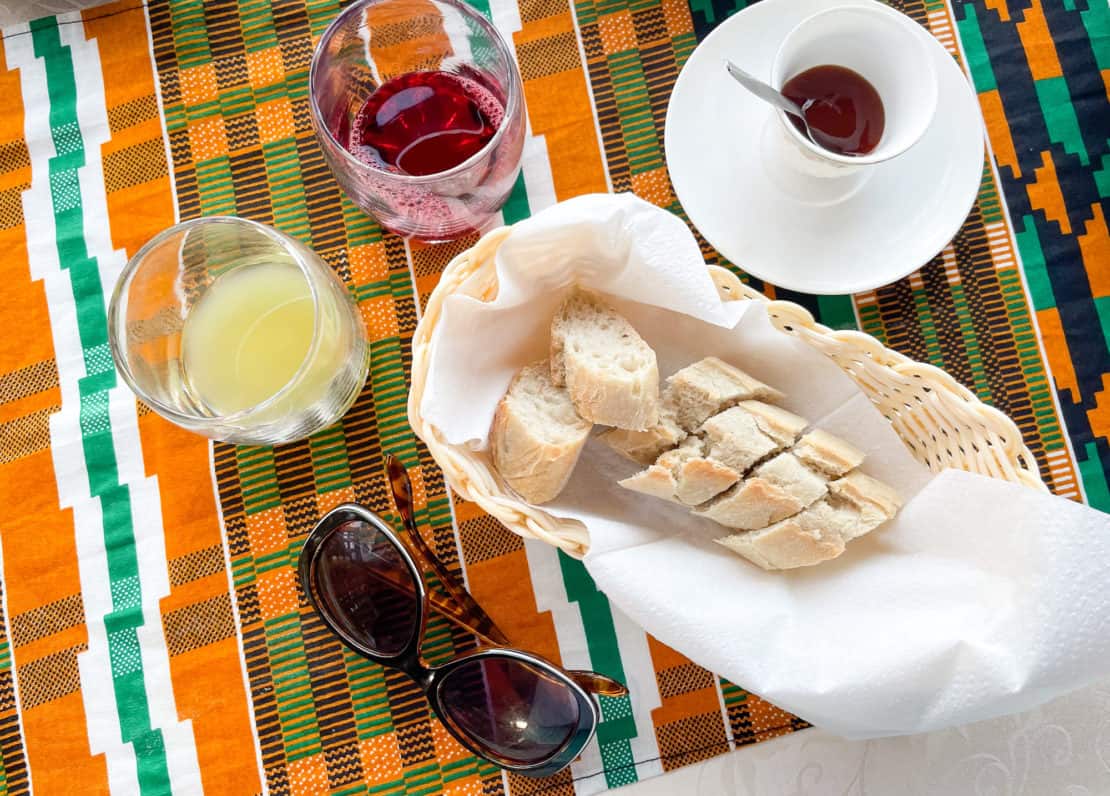
Tapalapa (Bread)
Most stews in The Gambia are served with a local bread called tapalapa. At first sight, it looks like a French baguette, but the texture is completely different. Tapalapa is made from a mixture of millet, wheat, cowpea, and maize flour, which makes it dense and heavy. It has a crunchy exterior, and its taste is similar to soft pretzels.
You’ll also find it at breakfast in many places, where I absolutely loved it.
Gambian Desserts
Thiakry
If you want to try something sweet in The Gambia, pick thiakry, a dessert specific to this part of the world.
It is light and filling at the same time, made with wheat or millet granules, condensed milk, milk, and yoghurt and flavoured with desiccated coconut, dried fruit, and nutmeg. Sometimes, you’ll find thiakry served at breakfast.
It’s easy to compare thiakry to tapioca or rice pudding, but it is quite different. Try it for yourself and see!
Cheese and Fruit
While you won’t find a typical cheese board, you will find lots and lots of succulent, tropical fruit. Produce is highly seasonal in The Gambia. On our last trip, we found mounds of watermelons but at other times, you won’t find any.
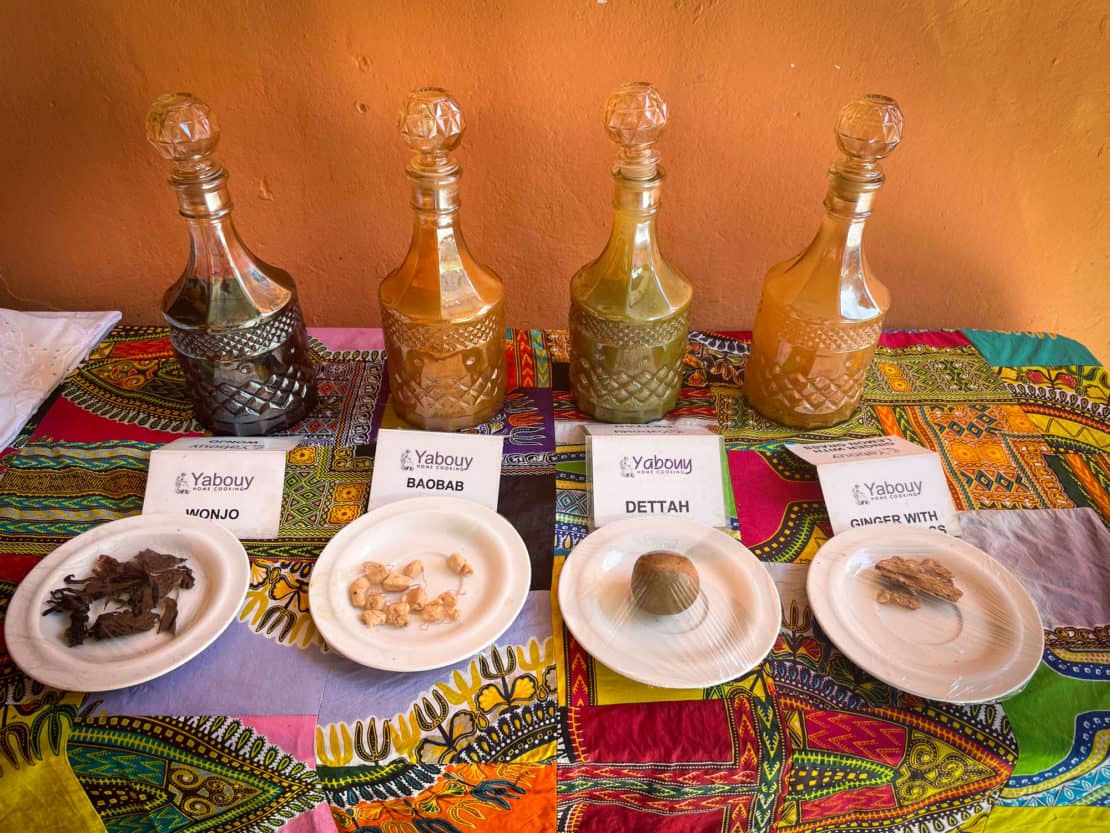
Traditional Gambian Drinks
Wonjo Juice
Days at the beach are hot in The Gambia, but don’t go for the classic lemonade or soda which you can try all around the world.
Instead, order a glass of Wonjo juice, also known as sorrel, bissap, hibiscus, or zobo juice. This non-alcoholic drink is made with hibiscus flowers, sweetened with sugar, and served cold. Local people drink it daily, but it is also an important part of local ceremonies.
Palm Wine
If you want to try something boozy, order a glass of palm wine. The colour and taste can vary greatly depending on when the juice was collected. If you’re not feeling adventurous, start with freshly collected palm wine: it is lighter and sweeter and has a cloudy white colour, somewhat like milk. You can also try fermented palm wine but prepare for a strong drink with a very pungent aroma.
Baobab Juice
If you are visiting The Gambia with kids, they will love this refreshing drink made from the brown fibre seeds of the baobab tree. And, quite possibly, so will you.
The baobab seeds are left to soak in water and then squeezed to obtain a milky juice. Sometimes, that’s the end of it, but often people add in sugar, condensed milk, and either banana or coconut to make things a bit more palatable.
Baobab juice is known for its iron, fibre, and vitamin C levels, apparently, and is one drink you can fairly easily find even in the hotels.
Detta
“It makes people thirsty,” whispered a young Gambian woman to me when I asked about this drink. “That’s why they serve it at the bar.”
Ginger with Lemongrass
As the name suggests, this non-alcoholic drink zings with ginger and lemongrass. But beware. It is punchy and can be super strong. No chance of a snooze after a sip of this!
Mbor Mbor
A delicious, mellow local tea made not from tea leaves but other herbs instead. It’s also caffeine free, which is a bonus for those of us who can’t touch the real thing.
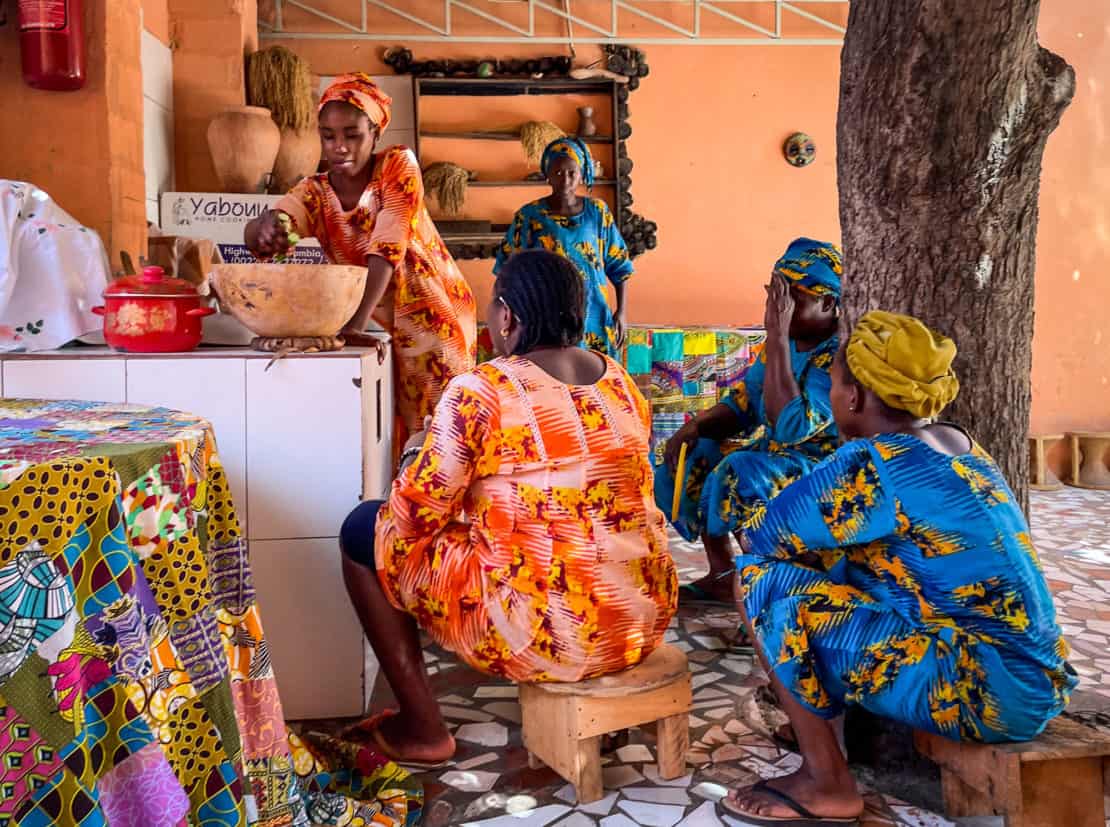
Taking a Cooking Class in The Gambia
If there’s one thing and one thing only you should do in The Gambia, it’s to meet Ida.
Ida Cham runs the cooking school at Yabouy in Tanji and she is, quite frankly, a force of nature.
On one level, you’ll have a relaxing day learning how to cook the traditional Gambian cuisine of your choice in a gorgeous courtyard, chatting and making friends and learning how to play wuri.
On the other, you’ll be challenged to think a little harder about the way you live your life and see the world through new eyes.
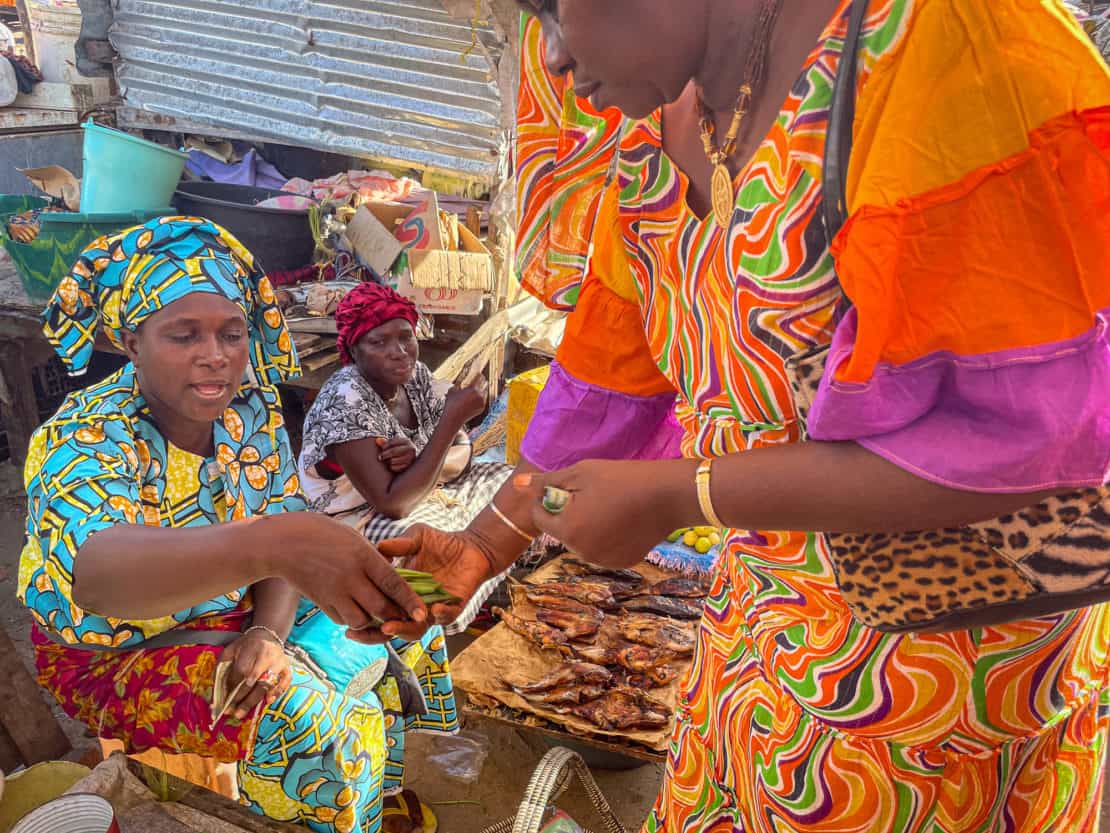
Visiting Tanji Fishing Market
The experience starts with a trip through the Tanji fishing market – dressed in traditional Gambian clothes. This is shock number one.
As it happens, I’d visited the market just a day or two before. No stranger to markets around the world, even Tanji surprised me with its intensity. Flowing coloured cloth, jostling elbows, tired plastic buckets and bowls on heads, wilting leaves, silver gleaming fish, spice mountains and smoke.
It’s a crowded, raw, real expression of exactly what it takes to get those basic ingredients from the shore and fields to our baskets and then on to our plates.
Standing out or fitting in?
With Ida, I saw a different view. In part because I’d been in the country a little longer and relaxed into the market’s frenetic pace, as contradictory as that sounds.
In part because we were actually shopping with a purpose instead of simply walking through.
But in no small part because Ida is tall, visible and seems to know everyone from stall to shore.
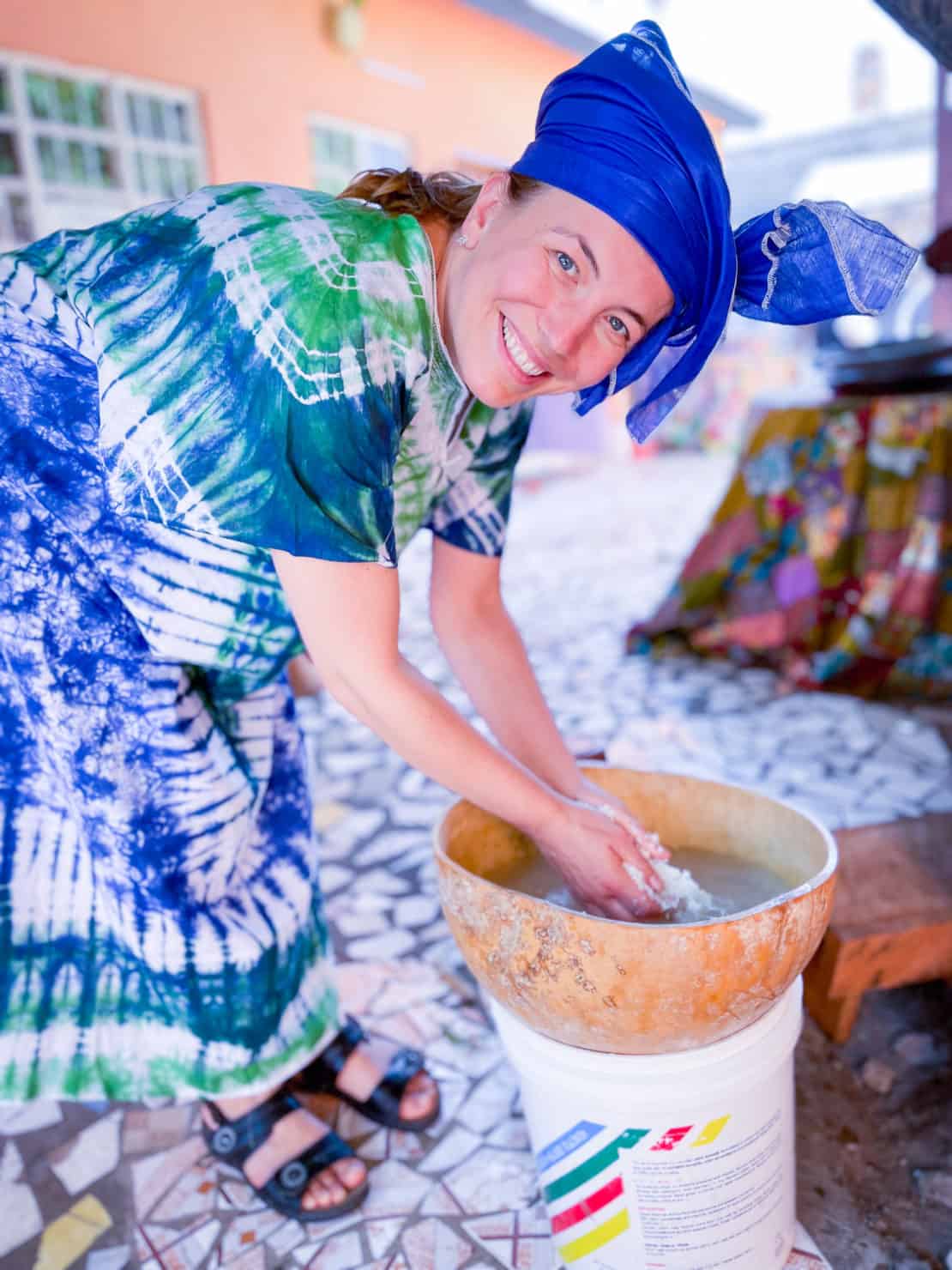
Dressing in traditional Gambian clothes
And finally? The outfit. I would have never risked wearing a traditional outfit like this out on my own. What if I was wearing it wrong? What if it was seen as offensive? What if it all fell off or fell down?
The reality was that it made me less “other “and I received fewer stares. People chatted to me as a person, rather than just the next faceless foreigner who would be here today and gone tomorrow.
Cooking Traditional Gambian Food
Of course, as with most of these cooking classes, guests roll up their sleeves and get involved. But someone else handles the washing up. We sat on traditional wooden stools, crushing herbs and vegetables with a giant kind of pestle and mortar.
Benachin is a slow recipe, one which takes patience and time. Allowing plenty of opportunities to talk to the women about their lives, their businesses and their ideas.
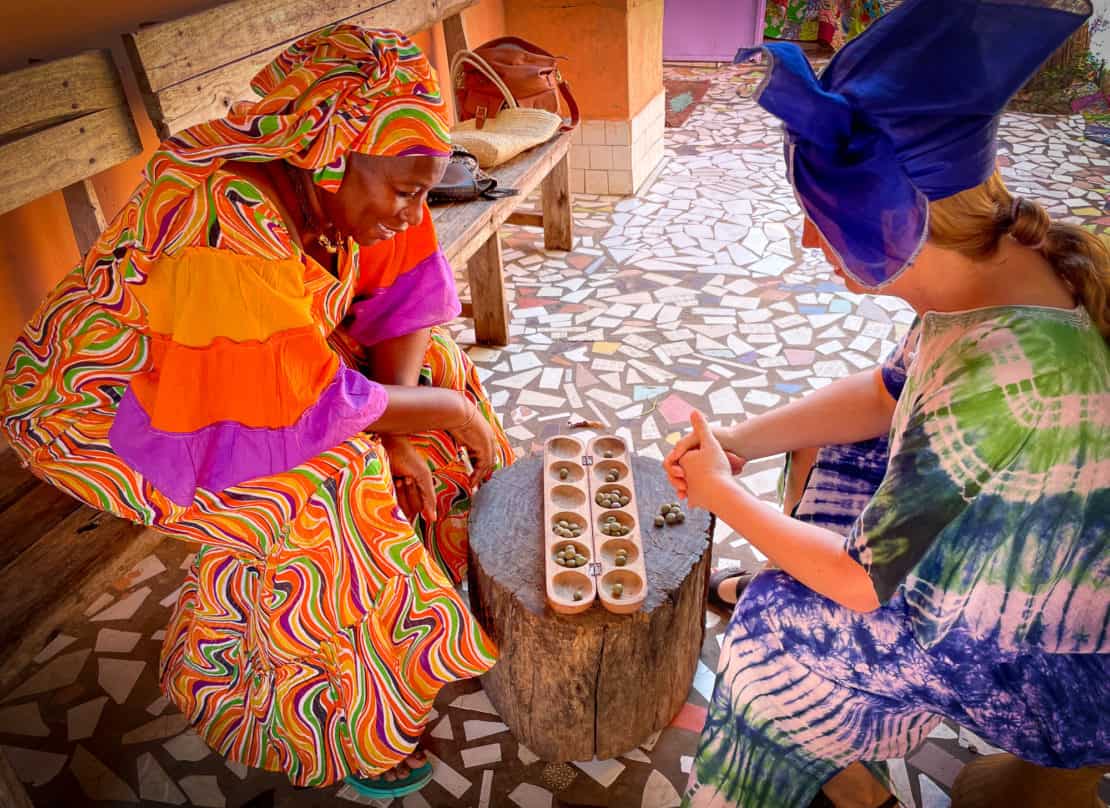
Chatting while the benachin boils
While Ida teaches me how to play The Gambian game of wurri, I talk but mostly listen.
Ida worked initially in the hospitality industry and spent a stint of time in London before opening up her cooking school. She has ambitious plans and has won many awards, with her Certificate of Recognition on the wall as an example.
But most of all, she is just good fun. Warm, welcoming and as passionate about the power of travel to good as me.
So, let’s say it one more time. Go and book a Gambian home cooking class with Ida!
Recommended places to eat in The Gambia
You can find most international food in the main hotels but it’s sometimes a little harder to track down some traditional Gambian dishes. Ask the managers and chefs in the resorts – and you can also look out for the following:
- Ida’s Cooking Class – I know I’ve mentioned this already but it’s just that good!
- Lamin Lodge will serve hot Gambian doughnuts with Gambian mbor mbor tea.
- You can pick up smoked fish at Tanji fishing market.
- The gorgeous Mandina Lodge arranges day visits with time on the water and in the jungle. They also serve, on request, traditional Gambian dishes. On weekdays, you can also take a trip on the water to taste fresh mussels.
- The Calypso Bar in the tourist area of Cape Point offers all the traditional Gambian drinks and you can watch the sun set over a crocodile pool.
- The Rainbow Beach Resort on Sanyang beach serves up each of the main three Gambian dishes right on the beach.
- Ngala Lodge cooks the freshest akara with a perfectly seasoned sauce on request for breakfast.
- Coco Ocean Resort & Spa has a lovely beachside restaurant where you can watch the sun set and sip cocktails.
More on Travel in Africa
- What to put on your Africa bucket list
- 21 brilliant and unusual things to do in Cape Town
- What we all need to know about ecotourism in Mauritius
- What safari guides really fear in the Okavango Delta in Botswana
- Namibia: exploring the oldest desert in the world
- Ouirgane valley: the most beautiful part of Morocco?
- Why South Africa is called the Rainbow Nation
- What you need to know before you climb Kilimanjaro
- What to add to your Kenya bucket list
- The best beaches in Madagascar for you to relax on
- The highs and lows of driving in Morocco
- Why colour still matters in Cape Town’s Bo Kaap
- Where to find the real Pride Rock

